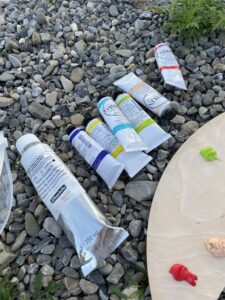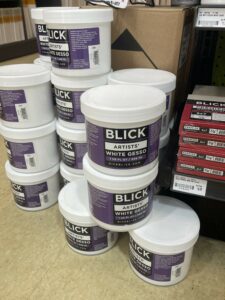The best way to apply gesso is to clean your canvas, mix your gesso, dillute your gesso, use a large flat or filbert brush to apply it, wait fo it to dry, add many coats, and sand it (if you want).
How to gesso correctly
Materials You’ll Need:
- Canvas
- Gesso (acrylic or oil-based, depending on your painting medium)
- Palette knife or stirring stick (if using a tub of gesso)
- Brushes (typically a large flat or filbert brush for applying gesso)
- Water (for acrylic gesso)
- Palette or disposable plate
- Drop cloth or newspaper to protect your work surface
- Sandpaper (optional, for smoothing the surface)
Steps to apply gesso
Prepare Your Workspace:
Cover your work surface with a drop cloth or newspaper to protect it from gesso spills.
Check Your Canvas:
Ensure your canvas is clean and free of dust or debris. If you’re working with a store-bought canvas, it’s usually pre-primed with a thin layer of gesso. However, adding an additional layer of gesso can provide better coverage and control over the surface texture.
Mix the Gesso (if needed):
If you’re using gesso from a tub, stir it thoroughly using a palette knife or stirring stick. Make sure it’s well-mixed and has a consistent texture.
Dilute the Gesso (if using acrylic gesso):
If you’re using acrylic gesso, you can dilute it with a small amount of water to achieve a smoother application. Start with a 1:1 ratio (equal parts gesso and water) and adjust as needed. Some artists prefer a thicker application, while others like a slightly more watery consistency for smoother coverage.
Apply the First Coat:
Using a large flat or filbert brush, dip it into the gesso and start applying it to the canvas. Work in even, overlapping strokes, covering the entire canvas surface. Make sure you distribute the gesso evenly and avoid leaving brush marks or streaks. Allow the first coat to dry completely (usually a few hours to overnight, depending on the thickness and humidity).
Sand and Smooth (optional):
If you want an even smoother surface, you can lightly sand the dried first coat of gesso with fine-grit sandpaper (around 220-320 grit) before applying subsequent coats. This step is optional but can be useful for achieving a polished finish.
Apply Additional Coats (if necessary):
Depending on your preference and the texture you desire, you can apply one or more additional coats of gesso. Each coat should be applied in the same manner as the first, allowing each layer to dry before adding the next. Additional coats can help build up the surface texture and provide a more solid base for your painting.
Final Surface Preparation:
Once you’ve achieved the desired surface texture and coverage, your canvas is ready for painting. You can now start your artwork using the medium of your choice, whether it’s acrylics, oils, or any other compatible medium.
By following these steps and taking your time to apply gesso properly, you’ll create a well-prepared canvas that enhances the longevity and quality of your artwork.
If this interests you, check out these related posts.


